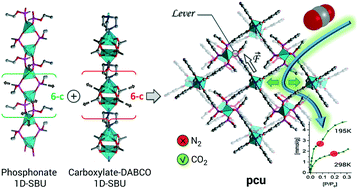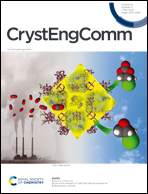Flexible bifunctional monoethylphosphonate/carboxylates of Zn(ii) and Co(ii) reinforced with DABCO co-ligand: paradigmatic structural organization with pcu topology†
Abstract
Two novel isostructural phosphonate-monoethylcarboxylate MOFs with the structural formula of [M2(EtBCP)2(DABCO)0.5]·2DMA (M = Zn (2), Co (3); H2EtBCP = O-ethyl-P-(4-carboxyphenyl)phosphonic acid, DABCO = 1,4-diazabicyclo[2.2.2]octane, DMA = N,N-dimethylacetamide) were synthesized and characterized. The frameworks of 2 and 3 are sustained by {Zn2(PO2(OEt))2}n metal-phosphonate- and DABCO-extended {Zn2(COO)4(DABCO)}n paddle-wheel carboxylate chain-SBUs. The chains providing connectivity in three, mutually orthogonal directions are running parallel and are combined in a framework, which could be interpreted as having a pcu topology. The simple structure-organization principle, which suggests the possibility of the elongation of the bifunctional ligand with scaling in two directions, allows to view the structures of 2 and 3 as prototypes for an isoreticular series. The porosity of both compounds, based on a relatively short ligand, is low: no adsorption of N2 was registered, however, CO2 is adsorbed readily allowing to estimate the surface area at ∼330 m2 g−1 (∼900–1060 m2 g−1 geometric estimate). The compounds demonstrate a two-step CO2 adsorption isotherm both at 195 K (0–1 bar) and 298 K (0–20 bar). The adsorption isotherms are characterized by a gradual (type “F-I”), albeit still relatively steep onset of the second step, associated with structural flexibility/bistability. The estimated pore volumes at the start of the transformation (195 K) for 2 and 3 are ∼0.11 (0.08P/P0) and 0.12 cm3 g−1 (0.12P/P0) respectively, which corresponds considerably well to the geometrically calculated accessible volume of ∼0.07 cm3 g−1 for the experimental structure (3.3 Å probe diameter). The structural prerequisites of the observed flexibility of the framework, which might be associated with the non-planarity of the metal-phosphonate moieties, acting as ‘levers’ for propagating mechanical stress, are discussed.

- This article is part of the themed collection: Introducing the CrystEngComm Advisory Board and their research


 Please wait while we load your content...
Please wait while we load your content...